manual canon 80d
The Canon EOS 80D manual is an essential guide for mastering your camera. It provides detailed instructions for unlocking its full potential, covering basic operations and advanced features. Download the PDF manual from Canon’s official website for comprehensive tutorials and troubleshooting tips. Ensure you use Adobe Reader 6.0 or later to view the file properly.
Overview of the Canon EOS 80D
The Canon EOS 80D is a versatile DSLR camera designed for both enthusiasts and professionals. It features a 24.2MP APS-C CMOS sensor, DIGIC 6 image processor, and 45-point all-cross-type AF system for precise autofocus. The camera supports Wi-Fi and NFC connectivity, enabling easy file transfer and remote shooting. With a vari-angle touchscreen LCD and Full HD video recording, the EOS 80D is ideal for photography and videography. The manual provides detailed guidance on its features, ensuring users can maximize its capabilities effectively. Download the PDF manual for a comprehensive understanding of its functions.
Purpose of the Manual
The purpose of the Canon EOS 80D manual is to provide users with a comprehensive guide to understanding and utilizing the camera’s features. It covers basic operations, advanced settings, and troubleshooting tips. Whether you’re a novice or an experienced photographer, the manual ensures you can navigate the camera’s capabilities confidently. Detailed instructions on shooting modes, autofocus, and video recording are included. The manual also explains how to customize settings and maintain the camera for optimal performance. By following the manual, users can unlock the EOS 80D’s full potential and enhance their photography experience.
System Requirements for Viewing the Manual
To view the Canon EOS 80D manual, ensure your device meets the necessary requirements. Use Adobe Reader 6.0 or a later version to open the PDF file. Older versions, such as Adobe Acrobat Reader 4.x, are not supported. The manual is provided in PDF format, making it accessible across multiple platforms. Ensure your device has a compatible PDF viewer installed to access the guide effectively. This ensures you can navigate the manual seamlessly and make the most of its detailed instructions and features.
Key Features of the Canon EOS 80D
The Canon EOS 80D boasts a 24.2MP APS-C CMOS sensor, DIGIC 6 processor, and 45-point AF system for precise focus. It supports 1080p video recording and features a vari-angle touchscreen LCD for enhanced creativity and control.
Camera Specifications
The Canon EOS 80D features a 24.2-megapixel APS-C CMOS sensor and a DIGIC 6 image processor. It supports an ISO range of 100-16000 (expandable to 25600) and shoots continuously at up to 7 fps. The camera includes a 3-inch vari-angle LCD touchscreen and a 45-point all-cross-type AF system for precise focusing. It also supports 1080p Full HD video recording at 60 fps. The EOS 80D is compatible with EF and EF-S lenses, making it versatile for various photography needs.
New and Improved Features
The Canon EOS 80D introduces several enhancements, including a 45-point all-cross-type AF system for faster and more precise focusing. It also features Dual Pixel CMOS AF for smooth autofocus during live view and video recording. The camera boasts improved low-light performance with an expanded ISO range of 100-16000. Additionally, it includes built-in Wi-Fi and NFC for seamless connectivity and image transfer. The vari-angle 3-inch LCD touchscreen offers enhanced composability. These upgrades make the EOS 80D a versatile choice for photographers seeking advanced functionality and image quality.
Compatibility with Lenses and Accessories
The Canon EOS 80D is compatible with a wide range of EF and EF-S lenses, offering flexibility for various shooting styles. It also supports EF-mount accessories like flash units and remote controllers. The camera works seamlessly with Canon’s Speedlite flash system for enhanced lighting control. Additionally, it is compatible with Canon’s EF-S 18-135mm f/3.5-5.6 IS USM kit lens, ensuring versatile shooting options. This extensive compatibility makes the EOS 80D a versatile tool for both casual and professional photographers, allowing for easy integration of additional gear to suit different creative needs.
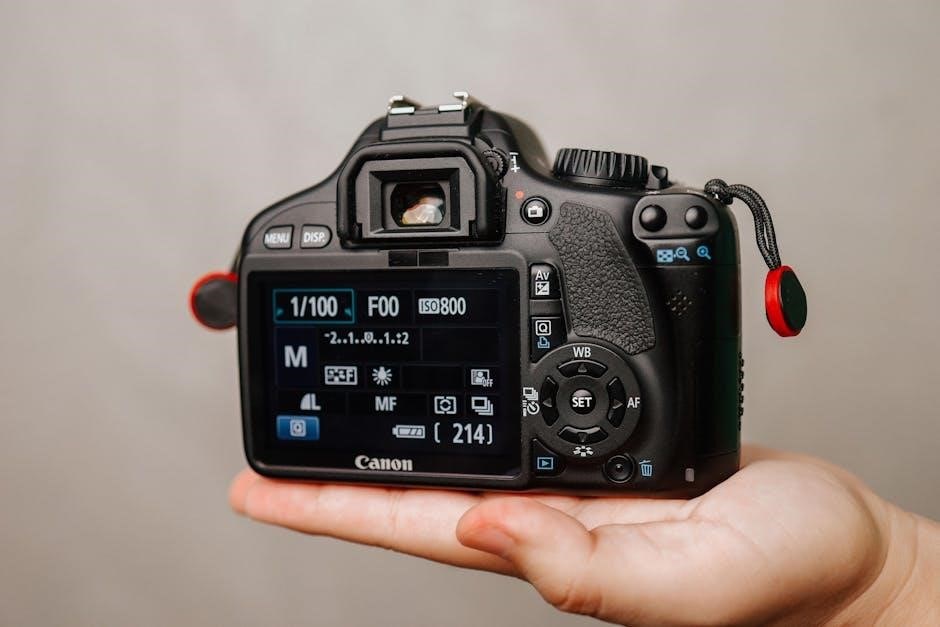
Setting Up the Canon EOS 80D
Unbox and charge the battery, then insert a memory card. Familiarize yourself with basic controls like the mode dial and shutter button for smooth operation.
Unboxing and Initial Setup
Start by carefully unboxing your Canon EOS 80D. Ensure all accessories, including the battery, charger, and lens, are included. Before turning on the camera, charge the battery fully using the provided charger. Insert the memory card into the designated slot, making sure it clicks securely into place. Power on the camera and follow the on-screen instructions to set your language, date, and time. Familiarize yourself with the camera’s buttons and dials to prepare for your first shoot.
Charging the Battery
To charge the Canon EOS 80D battery, use the provided LP-E6N battery charger. Plug the charger into a power outlet and insert the battery pack. Ensure the charger is Canon-approved to avoid damage. Charging typically takes about 2 hours. The charger will indicate when the battery is fully charged. Avoid overcharging, as it may reduce battery life. Once charged, remove the battery from the charger and insert it into the camera. Always check the battery level before shooting to ensure uninterrupted use.
Inserting the Memory Card
To insert a memory card into the Canon EOS 80D, open the card slot cover located on the right side of the camera. Ensure the camera is off before proceeding. Orient the memory card with the label facing towards the camera and gently push it into the slot until it clicks. Close the card slot cover securely. The camera will recognize the card automatically. Do not force the card into the slot, as this may cause damage. Always use compatible memory cards for optimal performance.
Basic Camera Controls
Familiarize yourself with the Canon EOS 80D’s essential controls. The mode dial on top allows you to switch shooting modes. The shutter button is located on the right, used for capturing images and starting video recording. Adjust aperture with the aperture control on the rear. The ISO button is nearby, enabling quick sensitivity adjustments. Use the Quick Control Dial to modify settings like shutter speed or aperture. The navigation buttons help select autofocus points and navigate menus. Understanding these controls is key to effective camera operation.
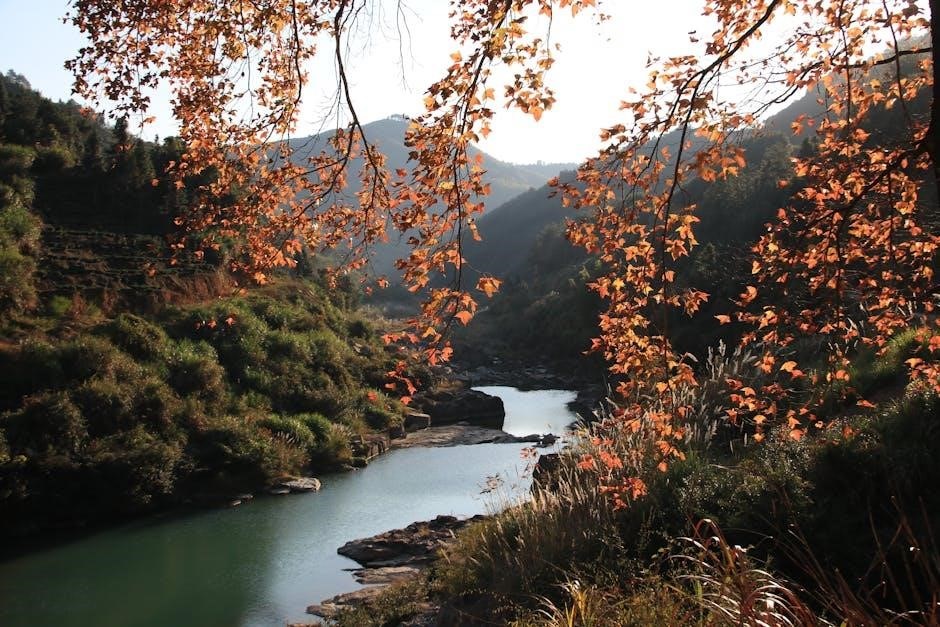
Shooting Modes and Settings
The Canon EOS 80D offers versatile shooting modes, including Manual (M), Aperture Priority (Av), and Shutter Priority (Tv), enabling precise control over exposure and creative photography.
Understanding the Mode Dial
The mode dial on the Canon EOS 80D simplifies switching between shooting modes. Rotate it to select options like Auto, P, Tv, Av, M, and custom modes (C1-C3). Each mode offers unique control levels, from fully automatic to manual. Use the dial to choose the mode that best suits your scene and creative vision, ensuring optimal results in various photography scenarios. This feature is designed for both beginners and advanced users to enhance their shooting experience. The dial’s intuitive design makes mode selection quick and efficient, allowing seamless transitions between settings. By familiarizing yourself with the mode dial, you can maximize the camera’s capabilities and achieve professional-quality images. The Canon EOS 80D’s mode dial is a key tool for unlocking your photographic potential.
Manual Mode (M)
Manual Mode (M) on the Canon EOS 80D gives you complete control over aperture, shutter speed, and ISO. This mode is ideal for experienced photographers who want precise control over their shots. By adjusting these settings manually, you can achieve the exact exposure and creative effect you desire. Use the aperture and shutter speed dials to set your preferences, and adjust ISO as needed for optimal results in various lighting conditions. Manual Mode is perfect for capturing unique styles and mastering advanced photography techniques. It allows you to experiment and refine your skills for professional-quality images.
Aperture Priority Mode (Av)
Aperture Priority Mode (Av) on the Canon EOS 80D allows you to set the aperture while the camera automatically adjusts the shutter speed. This mode is ideal for controlling depth of field, ensuring your subject stands out while the background is blurred or sharp; Adjust the aperture using the dial, and the camera will optimize the shutter speed for proper exposure. Use Av for portraits, landscapes, or creative compositions where depth of field is crucial. It offers flexibility and ease, making it a favorite among photographers for precise control over their images’ aesthetics and focus.
Shutter Priority Mode (Tv)
Shutter Priority Mode (Tv) lets you set the shutter speed while the camera automatically adjusts the aperture. Ideal for capturing motion, Tv mode is perfect for freezing fast-moving subjects or creating artistic blur. Use the dial to select speeds for sports, wildlife, or creative effects like flowing water. The EOS 80D ensures proper exposure by adjusting the aperture accordingly. This mode is versatile for experimenting with dynamic compositions and achieving desired motion effects in your photography, making it a valuable tool for creative expression and technical precision.
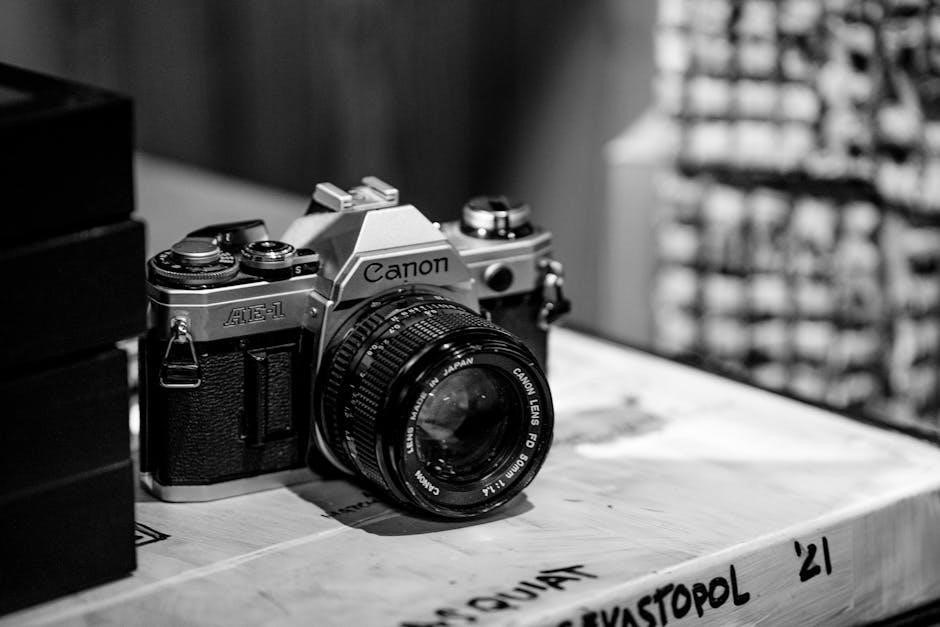
Autofocus and Metering
The Canon EOS 80D features advanced autofocus and metering systems for precise control. Its 45-point AF system ensures sharp focus, while metering modes optimize exposure for stunning results in various lighting conditions.
Autofocus Modes
The Canon EOS 80D offers multiple autofocus modes to suit different shooting scenarios. One-Shot AF is ideal for stationary subjects, focusing quickly and accurately. AI Servo AF is designed for moving subjects, tracking motion continuously. AI Focus AF automatically switches between One-Shot and AI Servo, adapting to subject movement. Additionally, Manual Focus allows for precise control by the user. These modes ensure versatility and sharp results in various photography situations.
AF Point Selection
The Canon EOS 80D allows precise control over autofocus with its 45 cross-type AF points. Use the AF Point Selection button to manually select a single AF point or switch to Zone AF for broader coverage. The AF point selection is accessed via the camera’s menu or by using the multi-controller. Highlighting active AF points in red ensures clear visibility. This feature enhances focus accuracy, enabling photographers to achieve sharp results in various compositions. Customizing AF point selection boosts efficiency during shoots, making it a powerful tool for professionals and enthusiasts alike.
Metering Modes
The Canon EOS 80D features four metering modes to ensure accurate exposure. Evaluative Metering analyzes the entire scene for balanced results. Center-Weighted Metering prioritizes the center of the frame. Spot Metering measures light from a specific area, ideal for backlit subjects. Partial Metering covers a larger area than Spot Metering, offering a compromise. Access these modes via the camera’s menu or the metering mode button, then use the multi-controller to select the desired option. This versatility helps photographers achieve precise exposure control in various lighting conditions.

ISO and White Balance Settings
The Canon EOS 80D allows adjusting ISO sensitivity (100-16000) for low-light photography and features various White Balance options, including Auto, Daylight, and custom settings, to capture accurate colors;
ISO Sensitivity
The Canon EOS 80D offers a wide range of ISO sensitivity settings, from 100 to 16000, allowing for flexible shooting in various lighting conditions; The camera also features an expandable ISO range up to 25600 for extreme low-light situations. Adjusting the ISO is straightforward using the Quick Control dial or the ISO button on the camera. The manual provides detailed guidance on optimizing ISO settings to minimize noise and achieve the best image quality. Additionally, the Auto ISO feature allows the camera to automatically adjust sensitivity based on the scene.
White Balance Options
The Canon EOS 80D provides multiple white balance options to ensure accurate color representation. Preset modes include Auto, Daylight, Shade, Tungsten, White Fluorescent, and Custom. The Custom white balance allows setting a specific color temperature (2500K–10000K) for precise control. Fine-tuning options enable adjustments to suit various lighting conditions. The manual emphasizes the importance of correct white balance for capturing natural colors. Additionally, the camera supports storing up to five custom white balance settings for quick access. This feature enhances flexibility in diverse shooting environments.
Playback and Review
The Canon EOS 80D allows easy image review post-capture. Use the LCD screen to check shots, delete unwanted files, and protect favorites from accidental deletion. Zoom in to inspect details or scroll through images using the cross keys. Playback options include slideshow mode and histogram display for exposure verification. Quickly access protected files or erase multiple images at once for efficient management.
Reviewing Images
To review images on the Canon EOS 80D, press the Playback button. Use the cross keys to scroll through photos. Zoom in using the Zoom button to inspect details. Press the INFO button to cycle through display options, including histogram and shooting information. Protect images from deletion by pressing the Protect button. For quick access, use the index display to view multiple images at once. This feature enhances workflow efficiency and helps in organizing your photos effectively during post-shooting review sessions.
Deleting and Protecting Files
To delete files on the Canon EOS 80D, press the Trash button during playback. Select the image you wish to delete and confirm. For multiple deletions, use the Quick Control screen to choose specific files. To protect files from accidental deletion, press the Protect button during playback. Protected images are marked with a lock icon and cannot be deleted. This feature ensures your important shots remain safe. Use these options to manage your photos efficiently and maintain organization in your library.

Customizing the Camera
The Canon EOS 80D allows users to save custom shooting modes (C1, C2, C3) and customize functions to suit their preferences, enhancing personal shooting experiences.
Custom Shooting Modes (C1, C2, C3)
The Canon EOS 80D allows users to save custom shooting modes (C1, C2, C3) for quick access to preferred settings. These modes enable photographers to store unique combinations of camera settings, such as ISO, aperture, and shutter speed, tailored to specific shooting scenarios. This feature enhances efficiency and ensures consistent results. Detailed instructions for setting up and using these modes can be found in the Canon EOS 80D manual, available for download on the Canon website. Use Adobe Reader 6.0 or later to view the PDF file.
Custom Functions
Custom Functions on the Canon EOS 80D enable users to personalize camera settings to suit their preferences. These functions allow adjustments to autofocus, metering, and exposure control, among others. For detailed guidance, refer to the Canon EOS 80D manual, available as a PDF on Canon’s website. Ensure you use Adobe Reader 6.0 or later to access the file. This feature is particularly useful for advanced photographers seeking to optimize their shooting experience.

Video Recording
The Canon EOS 80D supports high-quality video recording. Start recording by pressing the Live View/Movie Shooting button. Choose from resolutions like 1080p at 60fps for smooth footage.
Starting Video Recording
To begin video recording on your Canon EOS 80D, switch to Movie mode using the Mode Dial. Press the Live View/Movie Shooting button to activate the video mode. Before recording, ensure settings like resolution, frame rate, and autofocus are configured. Once ready, press the Start/Stop button to begin recording. Use the same button to stop recording. For detailed instructions, refer to the Canon EOS 80D manual, available as a PDF on the Canon website. Ensure you use Adobe Reader 6.0 or later to view the file correctly.
Video Settings and Quality
The Canon EOS 80D offers versatile video settings to enhance your recording experience. You can choose from various resolutions, including 1080p at 60fps, and select between MP4 and MOV file formats. Adjust settings like autofocus, exposure compensation, and audio levels for optimal results. Enable manual focus for precise control or use Continuous AF for dynamic subjects. Customize White Balance and Picture Style to match your creative vision. For detailed guidance, refer to the Canon EOS 80D manual, available as a downloadable PDF on the Canon website. Ensure you use Adobe Reader 6.0 or later for proper viewing.
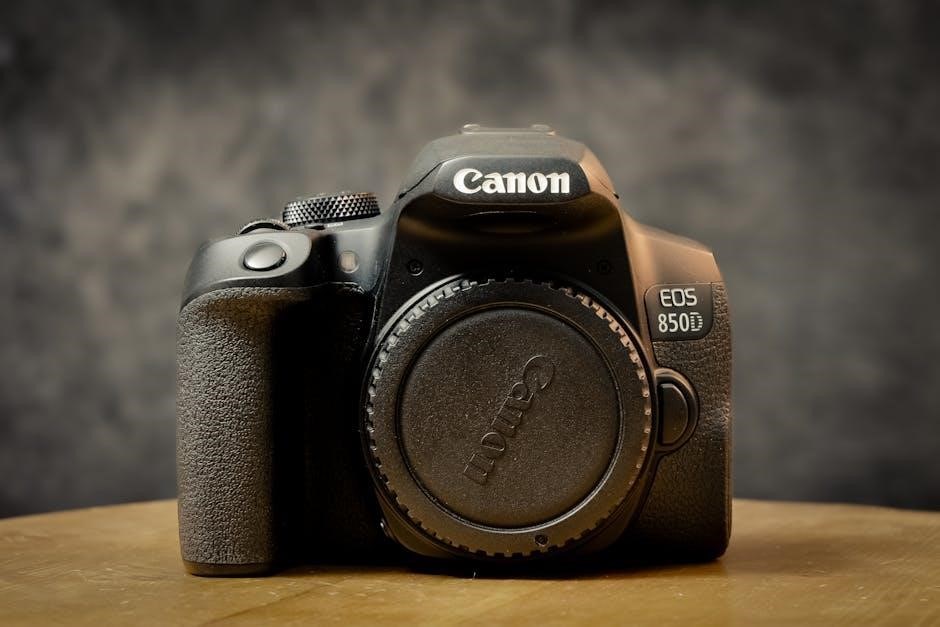
Connectivity and Transfers
The Canon EOS 80D supports Wi-Fi and NFC for easy connectivity. Transfer images to your computer using EOS Utility or via Wi-Fi/NFC connections seamlessly. Visit the Canon website for detailed instructions.
Wi-Fi and NFC Connectivity
The Canon EOS 80D features built-in Wi-Fi and NFC capabilities, enabling seamless image transfers to compatible devices. Connect to smartphones, tablets, or computers using the Camera Connect app. NFC allows one-touch pairing with Android devices. For setup, access the camera’s menu, select Wi-Fi options, and follow on-screen instructions. Ensure your device supports Wi-Fi Direct for direct transfers. Visit the Canon website for detailed instructions and compatibility information. This feature enhances workflow efficiency and sharing convenience for photographers.
Transferring Images to a Computer
Transfer images from your Canon EOS 80D to a computer via USB, Wi-Fi, or using the EOS Utility software. Connect the camera directly using a USB cable, or use Wi-Fi for wireless transfers. For Wi-Fi, enable the camera’s Wi-Fi function, connect to your computer’s network, and use the EOS Utility or Camera Connect app; Visit the Canon website for detailed instructions and software downloads. This ensures efficient image management and backup, enhancing your workflow and organization.
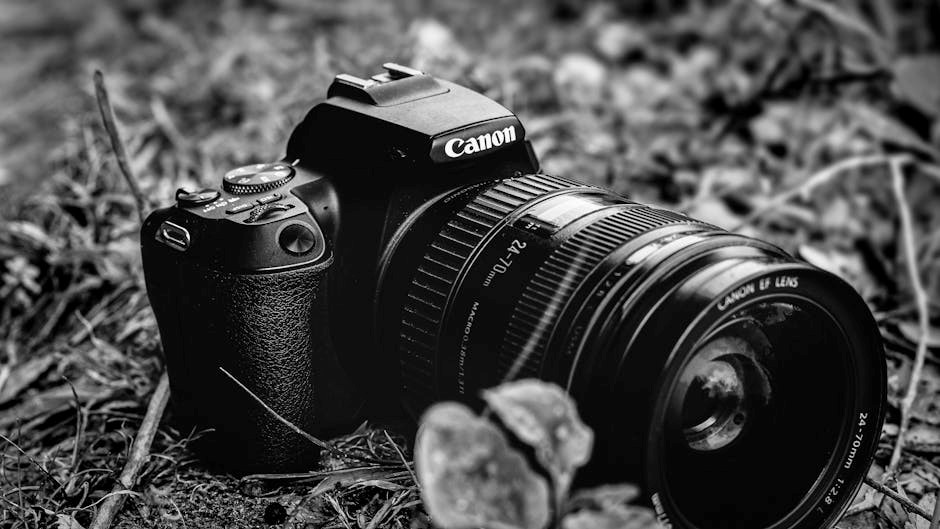
Maintenance and Troubleshooting
Regularly clean the sensor and lens for optimal performance. Check firmware updates and refer to the manual for solutions to common issues like error messages or connectivity problems.
Cleaning the Sensor and Lens
Cleaning the sensor and lens is crucial for maintaining image quality. Turn off the camera, then gently remove dust with a soft brush or blower. For stubborn spots, use a cleaning swab with a small amount of cleaning solution. Avoid touching the lens surface and never use harsh chemicals. Regular cleaning prevents smudges and ensures sharp photos. Refer to the manual for detailed steps and recommendations to avoid damaging your equipment. Proper maintenance extends the life of your Canon EOS 80D.
Common Issues and Solutions
Common issues with the Canon EOS 80D include blurry photos, error messages, and Wi-Fi connectivity problems. For blurry images, check autofocus settings and ensure the lens is clean. Error messages often require resetting the camera or updating firmware. Wi-Fi issues can be resolved by restarting the camera and ensuring a stable connection. Visit the Canon support website for detailed troubleshooting guides and firmware updates to resolve these issues effectively and maintain optimal camera performance. Regular updates help prevent recurring problems.
Downloading Additional Manuals
Visit the Canon website to download detailed PDF manuals for the EOS 80D. Ensure you use Adobe Reader 6.0 or later for proper viewing. www.canon.com
Accessing Detailed PDF Manuals
To access detailed PDF manuals for the Canon EOS 80D, visit the official Canon website at www.canon.com. Navigate to the support section and search for the EOS 80D. Download the comprehensive instruction manual, which covers advanced features and troubleshooting. Ensure you use Adobe Reader 6.0 or later to view the PDF files correctly. Additional resources, including software and firmware updates, are also available on the Canon website for optimal camera performance and functionality.
Canon Website Resources
The Canon website offers extensive resources for the EOS 80D, including detailed manuals, software, and firmware updates. Visit www.canon.com to explore guides, tutorials, and troubleshooting tips. The site provides easy access to download the latest versions of EOS Utility and Digital Photo Professional. Additionally, Canon’s support section includes FAQs, driver downloads, and customer service options. These resources ensure optimal camera performance and help users make the most of their EOS 80D experience.

Software and Firmware
The Canon EOS 80D supports EOS Utility software and firmware updates, available on Canon’s official website, ensuring optimal performance and access to the latest features.
EOS Utility Software
The EOS Utility Software is a powerful tool for Canon EOS 80D users, enabling image transfers, remote shooting, and firmware updates. Downloadable from Canon’s official website, it enhances camera control and workflow efficiency. Use it to adjust settings, capture images remotely, and organize photos seamlessly. Ensure you install the latest version for optimal compatibility and performance. This software is essential for maximizing your camera’s capabilities and streamlining your photography workflow. Refer to the manual for detailed installation and usage instructions.
Updating Firmware
Updating the firmware for your Canon EOS 80D is essential for maintaining optimal performance and accessing new features. To do this, visit the Canon website and navigate to the support section. Search for “Canon EOS 80D firmware update” to find the latest version. Check your camera’s current firmware version under the “Set Up” menu. If an update is available, download the correct file for your model and transfer it to the root directory of your memory card. Ensure the battery is fully charged, insert the card, and select the firmware update option in the menu. Follow on-screen instructions carefully and avoid interrupting the process. After completion, restart your camera. If issues arise, consult Canon’s support resources for assistance. Regular firmware updates help keep your camera functioning at its best.
